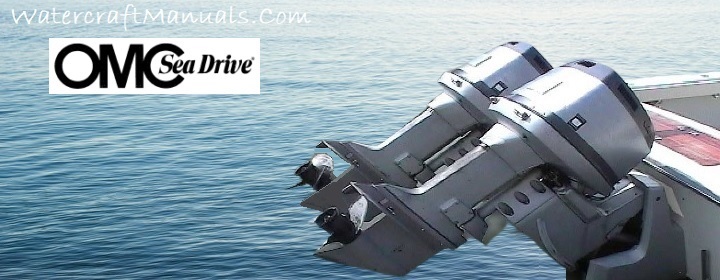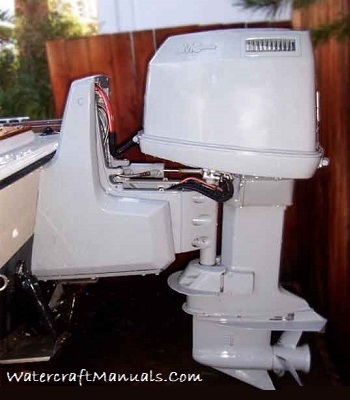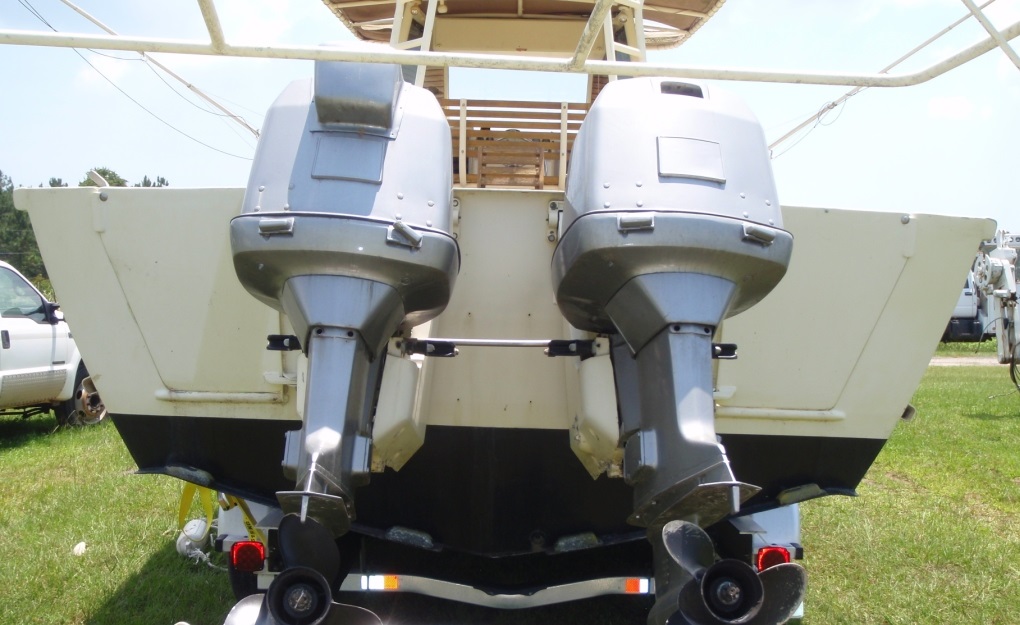
OMC Sea Drive Outboards, A Brief History
As early as 1981-1982, OMC began to offer its two-stroke outboard motors mounted in an innovative self-contained stern bracket and tilt mechanism called "Sea Drive". The Sea Drive was made in a number of conventional two-stroke engines of various displacements in V4 and V6 configuration. The Sea Drive was an alternative for both inboard/outboard (stern drive) power and for bracket-mounted outboards, which were just becoming popular at that same time. Production continued into the early 1990's.
In development of the Sea Drive, OMC reportedly used a 25-foot Bertram as a test boat. A boat rigged with Sea Drive engines was compared to a boat rigged with conventional inboard Ford 302 V-8 engines. The Sea Drive boat was about 10-MPH faster, used less fuel, and was quieter.
The earliest models of the Sea Drive provided a snorkel for air intake which ran in a rubber hose back through and inside the transom. This avoided problems with swamping when backing down in heavy seas. Outboard engines mounted on the popular Gill Bracket of that era often had problems from ingesting water, and OMC warned against use of their standard outboards in those applications. The snorkel also cut down on noise.
Some early models also featured electrically powered oil and gasoline mixing, the "Economixer". This was an expensive option and did not prove to work that well. It was often disconnected in use, and soon was dropped from production.
OMC Sea Drive Outboard OEM Factory Service and Repair Manuals
Jump to: Service Manuals / Parts Catalogs
 The
Sea Drive bracket was quite nicely engineered and over built. It was
also rather expensive. As the Sea Drive evolved, improvements added
weight, complexity, and cost. Rigging required special cut-outs in the
transom and other complex installation. In contrast, more conventional
brackets could just be bolted on and rigged with standard outboards
in much less time and for lower cost. Popularity declined, but production
of the Sea Drive continued into the early 1990's. Eventually OMC dropped
the Sea Drive, and went on to other ventures, such as the jet drive
adaptation used in the Boston Whaler RAGE series.
The
Sea Drive bracket was quite nicely engineered and over built. It was
also rather expensive. As the Sea Drive evolved, improvements added
weight, complexity, and cost. Rigging required special cut-outs in the
transom and other complex installation. In contrast, more conventional
brackets could just be bolted on and rigged with standard outboards
in much less time and for lower cost. Popularity declined, but production
of the Sea Drive continued into the early 1990's. Eventually OMC dropped
the Sea Drive, and went on to other ventures, such as the jet drive
adaptation used in the Boston Whaler RAGE series.
The Sea Drive worked quite well in its day, and it attracted the notice of Boston Whaler. Although, with the benefit of hindsight, many speak ill of the Sea Drive, its association with Boston Whaler as a factory supplied option might be considered an endorsement. Sea Drive power was first offered as an option on Boston Whaler boats in 1985. A Sea Drive has been seen installed on a Whaler as small as an OUTRAGE 18, but usually they were ordered on larger boats. The 25-foot and 27-foot models are the most frequently seen with Sea Drive installations, as well as the occasional 22-foot hull. By c.1988 the Sea Drive was no longer seen in the Boston Whaler catalogue. During its brief run, however, the Sea Drive must have been fairly popular, as many Boston Whaler boats from this era are seen equipped with Sea Drives.
The Sea Drive was often installed in pairs on larger boats, where more total horsepower was needed. As the engine was a conventional two-stroke cross-flow, it was not noted for being easy on fuel consumption, particularly when pushing around larger boats. Most of these large twin engine installations were made on boats intended for offshore use in salt water. Since the oldest Sea Drives are now entering their twentieth year, in most cases they are at the end of their useful life. Even Sea Drives pampered in seasonal fresh water use are often ready for replacement. In addition, the advent of much more economical four-stroke or direct-injection two-stroke outboard engines has also provided an incentive to replace the Sea Drive on larger boats.
The Sea Drive was an innovative idea, but OMC discontinued it in the early 1990's. They stopped providing support and parts a few years later. Currently, repair parts for the mounting and tilt system are not easily available, although the engine can be serviced with standard outboard parts. As a result, when a Sea Drive engine fails, the usual cure is to replace it with a conventional outboard mounted to an engine bracket.
The Sea Drive was quite innovative when introduced in the 1980's. It provided an integral engine setback bracket and tilt system. By locating the tilt pivot axis at an elevated height, OMC was able to conserve space needed for the engine when tilted. Instead of protruding into a transom splash well, the engine remained outside of the boat. In this way the space normally allocated for a splash well could be returned to the cockpit for other uses.
OMC Sea Drive Outboard Motors
